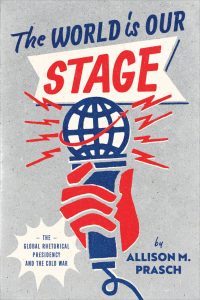Five Questions with Allison M. Prasch, author of “The World Is Our Stage”
Crowds swarm when US presidents travel abroad, though many never hear their voices. The presidential body, moving from one secured location to another, communicates as much or more to these audiences than the texts of their speeches. In The World is Our Stage, Allison M. Prasch considers how presidential appearances overseas broadcast American superiority during the Cold War through the movement of the president’s physical body. We spoke with Allison about her book and some of the ways that rhetoric is more than mere words.
How did you wind up in your field and what do you most value from your discipline?
I’ve always been fascinated by the US presidency, even as a child. I wrote my first middle school research paper on the White House and would watch the annual “State of the Union” address for fun during my high school years. It wasn’t until college that I learned about the field of rhetoric, which examines how and why individuals use speech to persuade audiences. When I learned that I could build a career studying US presidential rhetoric, I was hooked!
I approach my work as a rhetorical historian, which means I consider how rhetoric operates within and as a product of its historical, political, and social contexts. I appreciate the interdisciplinary nature of rhetorical history because it allows me to draw on theorists and writers from a variety of scholarly perspectives to build my argument.
While you were working on The World is Our Stage, what did you learn that surprised you the most?
All books are, in some way, motivated by a personal fascination with a topic or question that the author just can’t let go of. For me, that question was whether US presidents and their advisers believed that traveling abroad could function as a deliberate rhetorical strategy during the Cold War. I didn’t want to simply assume they did because it looked that way; I wanted to find the answer for myself. That’s why I started in the presidential archives—and discovered overwhelming evidence that US presidents from Truman to Reagan understood how powerful the act of going global could be. We often think of presidential rhetoric as being something limited to words uttered from a political stage, but it encompasses so much more than that.
What do you most hope readers will take away from your book?
I hope this book helps readers appreciate the complexity of presidential rhetoric at various moments in history. For a long time, scholars interested in US presidential rhetoric focused on the words chief executives say. This is, of course, very important. But in the book, I show how other facets of rhetorical performance—place, image, audience, body, and the circulation/mediation of texts—play a significant role in how US presidents reach publics at home and abroad. This is as true today as it was during the Cold War.
I also hope this project convinces people to visit US presidential libraries/archives across the country or access their collections online. They aren’t just available to academics; they’re open to the public! Although the archival research process for the book was the most challenging part, it was also the most rewarding. It’s amazing to read a declassified CIA memorandum written about JFK’s visit to West Berlin from the other side of the Berlin Wall or leaf through the briefing book Nixon took with him on Air Force One en route to China. It changes how you understand history and the presidents that contribute to that history.
Where will your research and writing take you next?
I’m currently writing a history of the rhetorical construction and spatial design of Washington, DC. In particular, I focus on the relationship between the city’s location (geographical and topographical) and the racial politics of the new nation. Why is it, for example, that Washington, DC was built between two slave-holding states (Virginia and Maryland) with direct access to waterways that made the trade of tobacco, cotton, and enslaved persons possible?
We often think about Washington, DC as this embodiment of freedom and democracy. But the city was literally built by and upon the institution of slavery and anti-Black racism. If you walk on the National Mall and see landmarks to Jefferson and Washington, you might not know that this space was also once the site of a slave market. In this new book, I ask how we first acknowledge and then reconcile that history.
This summer, I’ll be taking a research trip to Washington, DC to work in the National Archives and Library of Congress to continue the project. In many ways, this new book is asking similar questions to those I pursued in The World Is Our Stage. But where my first book analyzed how rhetorical strategies of movement, place, and embodiment influenced the Cold War global order, my second one asks how US politicians approached the spatial design and physical construction of Washington, DC as an opportunity to create, as French architect Pierre Charles L’Enfant put it to President George Washington, the “capital of an extensive empire.”
What’s the best book you’ve read recently?
I have a few books on my nightstand that I’m eager to finish now that my own book is finally complete. These include Isabel Wilkerson’s The Warmth of Other Suns: The Epic Story of America’s Great Migration, Clint Smith’s How the Word Is Passed: A Reckoning with the History of Slavery Across America, and Colin G. Calloway’s The Indian World of George Washington: The First President, the First Americans, and the Birth of the Nation.
Allison M. Prasch is assistant professor of rhetoric, politics, and culture at the University of Wisconsin–Madison.
The World is Our Stage is available now from our website or your favorite bookseller.
